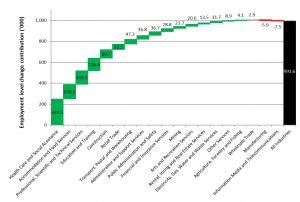Australia Industry Employment Outlook 2021
By Anna Gorna
The Australian National Skills Commission has published its employment projections by occupation and skill level for the five years to November 2025.
The Commission projected the following industries to grow in the next 5 years:
- Health Care and Social Assistance is projected to make the largest contribution to employment growth over the period (increasing by 249,500)
- Accommodation and Food Services (139,900)
- Professional, Scientific and Technical Services (131,100)
- Education and Training (118,600).
Together, these four industries are projected to generate over three-fifths (or 64.4%) of total employment growth[1] over the five years to November 2025.
The commission projected employment is likely to decline in Manufacturing (5900) and Information Media and Telecommunications (7500).

Source: Australian Labour Market Information Portal
INDUSTRY INSIGHTS
- Employment in Health Care and Social Assistance has been the primary provider of new jobs in the Australian labour market since the 1990s. The industry is expected to increase by 14.2 % over the next five years. Continued investment in public health care at state and federal levels supports this growth. Australia’s ageing population also contributes to this strong projected growth. Employment in this industry has been relatively resilient to the impact of COVID-19.
- Accommodation and Food Services employment is expected to recover from the pandemic and various restrictions. Whilst employment in the industry declined 2% from February to November 2020, the hope is that the hospitality industry will rebound strongly, increasing by 16.8% over the five years to November 2025. The growth is already seen in the Cafes, Restaurants and Takeaway Food Services and Accommodation sectors as a result of relaxed restrictions and increased domestic tourism. With further relaxation of international travel, the industry is expected to make a strong recovery in the coming years.
- Employment in Professional, Scientific and Technical Services is projected to increase by 0% over the five years to November 2025. The demand for the services of qualified and highly educated workers continues throughout the economy. Computer System Design and Related Services, Architectural, Engineering and Technical Services and Legal and Accounting Services are expected to drive the growth.
- The Education and Training sector is projected to increase by 10.8% over the five years to November 2025. The reduction in international students as a result of COVID-19 is expected to be offset by a larger school aged population and growing demand for adult and community education.
- Construction employment is projected to rise 6.8% over the five years with Building Installation Services and in Residential Construction to drive the employment rates up. The Government investment in infrastructure is reflected in an increase of employment in Heavy and Civil Engineering Construction sectors.
- Information Media and Telecommunications employment is projected to fall by 3.9%, continuing its long-term decline in employment. Employment in Telecommunications Services, Newspaper, Periodical, Book and Directory Publishing is likely to decline.
- Employment in Manufacturing is projected to fall by 0.7 % over the five years to November 2025. The long-term decline in some Manufacturing sectors is expected to continue, with employment in the Transport Equipment Manufacturing sector projected to decline by 9.0 % and in Textile, Leather, Clothing and Footwear Manufacturing sector by 15.3 %. There are early signs of growth in the Primary Metal and Metal Product Manufacturing sector, supported by significant domestic infrastructure investment and the redevelopment of modern manufacturing in Australia.
The Skills Commission projections are likely to be taken into account by the Department of Home Affairs in the skilled migration program reviews. As a result of the recent enquiry into Australia’s skilled migration program the committee made a list of recommendations, including an urgent review of the Priority Migration Skilled Occupation list with a view to expanding the number of occupations to better reflect the urgent skills shortages in the context of the COVID-19 pandemic recovery. The Committee recommended that the Department should give particular consideration to civil engineers, electrical engineers, motor mechanics, cooks, carpenters, electricians and other roles in the hospitality, health, trades, agriculture and manufacturing sectors. The Committee also recommends ‘’that the Short-term Skilled Occupation List, the Medium and Long-term Strategic Skills List and the Regional Occupation List be reviewed as soon as practicable to ensure that the lists most accurately reflect Australia’s employment challenges as the economy emerges from the COVID-19 pandemic.’’
So far, no changes have been announced to the current skilled occupation list.
In March 2020 the Department of Employment, Skills, Small and Family business announced a number of recommendations for various occupations to be removed or moved to other shortages lists. The suggested changes have never materialise as some of the recommendations might no longer be relevant taking into account the effect the pandemic has had on the economy and employment. As the true impact of the pandemic is starting to emerge, changes to the Australian Skilled Occupations list may be well expected to address the skills shortages as well as employment and industry projections in the various sectors.

